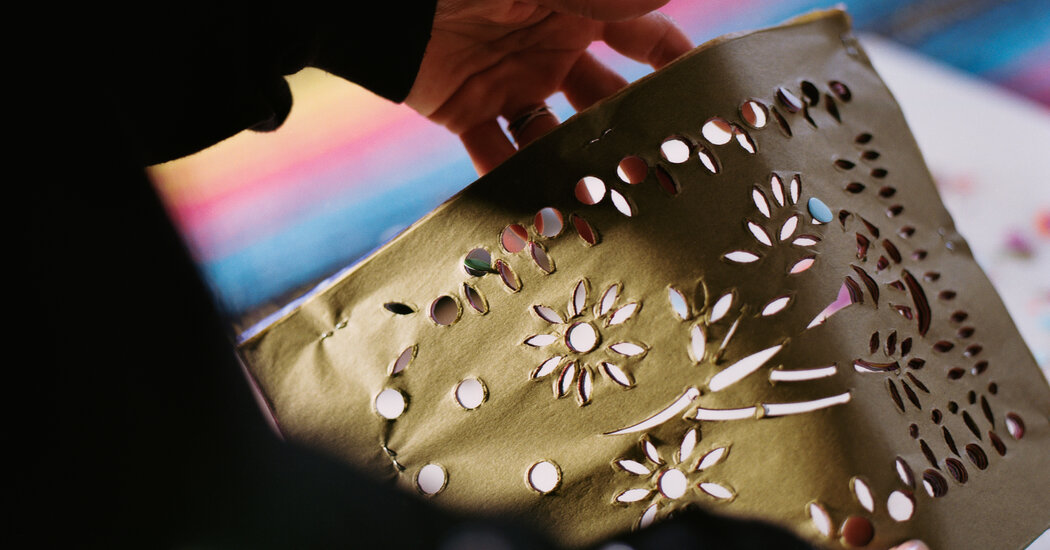Art of Craft is a series about craftspeople whose work rises to the level of art.
On a summer day in 2018, Blanka Amezkua arrived in San Salvador Huixcolotla. The southeastern Mexican town is best known as the birthplace of papel picado — intricately cut, colorful tissue-paper banners popular at Mexican festivities — and Amezkua had come hoping to learn the centuries-old techniques for crafting it. She flagged down a cab and asked the driver if he happened to know anyone who made the delicate paper flags. The man took her to his brother Don Rene Mendoza, who, by sheer chance, was a master of the trade. After speaking with Amezkua for more than five hours, Mendoza agreed to pass the craft tradition on to her.
Papel picado (“punched paper” in Spanish) has its roots in pre-Columbian times, when the Indigenous Nahuatl people of Mexico made amate paper from the bark of mulberry and fig trees, said Marcelo Alejandro Ramirez Garcia-Rojas, the curator of the International Museum of Art and Science in McAllen, Texas. Beginning in the 1500s, he said, “Spanish missionaries became deeply familiar with pre-Columbian traditions in an effort to combat them and convert local populations,” and practices such as amate production were discouraged or even banned. The Spanish also began importing papel chino — thin, tissue-like paper from China, often used to wrap other goods.
This confluence led to the creation of the papel picado used today to decorate a variety of celebrations in Mexican culture, most notably Day of the Dead, when it is placed around altars of deceased loved ones. The movement of the paper is said to signal the presence of the dead, and the delicate material symbolizes the ephemerality of life.
Day of the Dead “is my favorite holiday,” said Amezkua, 53, who identifies as Chicana. Born in Mexico, she migrated to California with her parents when she was 5 and then returned to Mexico at age 10, spending much of her adolescence living with her grandparents and many aunts in Cuernavaca, a city about a four-hour drive west of San Salvador Huixcolotla. (Her parents remained in California, where they worked on cotton farms.) On Saturdays, Amezkua would evade chores by accompanying her grandfather to the local market. While he bought food for the week, Amezkua would peruse the labyrinth of vendors selling fruits, textiles or used jars.
Amezkua went on to study painting at California State University, Fresno, but she credits the market with teaching her “all the lessons of installation art.” Holiday decorations and seasonal produce meant “the way the market gets dressed” changed dramatically over the course of a year, and many of the items sold were previously owned. Amezkua’s fascination with repurposed materials is reflected across her multidisciplinary work, which ranges from embroidered tortilla towels to performance art.
Amezkua started incorporating papel picado into her work in 2017 after she and her husband moved to the South Bronx from his native Greece, where they had resided for many years. Amezkua spent her first years back in the United States working on “Happiness Is …,” a 72-square-foot collage of confetti, streamers and the ubiquitous Mexican banners from her childhood. She was drawn in particular to the flags’ exuberant shades. “I often feel like the expression of color by native communities from any part of the world is a form of resistance,” she said.
The project began an obsession with papel picado.
A YouTube rabbit hole led her to San Salvador Huixcolotla, where traditional banners, cut by hand, continue to be a mainstay of the local economy — even as, like many folk crafts, papel picado is increasingly mass-produced.
Mendoza, the taxi driver’s brother, has been making papel picado for more than 30 years, and he taught Amezkua the hammer and chisel techniques that go back generations. He also introduced her to a blacksmith who made her a set of 116 steel chisels to take back to New York.
For such a delicate product, the making of papel picado is remarkably loud. It starts quietly enough, by drawing a design on a piece of unlined paper and stapling or clipping it to a stack of about 50 sheets of tissue paper. Then, using the top sheet as a guide, Amezkua cuts out the design with her chisels, driving each blade through the stack with a hammer. She typically works out of her apartment — luckily, she said, most of her neighbors are gone during the day — or in St. Mary’s Park, a short walk away. When she’s carving at home, she places moving blankets under a small table to help absorb the force and noise of each blow.
When the design is complete, Amezkua carefully separates the lacy flags. She uses a dab of diluted Elmer’s glue to secure them to a string stretched across her living room like a clothesline, the banners quivering in the air as light streams through each perforation.
Although the final product is beautiful, the process — which can take hours or even days, depending on the scale of the project — is time- and labor-intensive. “It’s almost like torture,” Amezkua said. But, she added, it’s also meditative: “It does something to your soul. My entire awareness of all the people that throughout time have created this specific type of work is different.”
Amezkua takes the responsibility of continuing that lineage seriously. She teaches papel picado workshops through Bronx Community College, and she continues to work with Mendoza. Last year, they collaborated on “Hierbitas de saberes/Tiny Herbs of Knowledge,” a series of large-scale papel picado pieces inspired by the “Cruz-Badiano Codex,” a book of Indigenous Mexican herbal remedies compiled in 1552; Amezkua created the designs and Mendoza translated them to paper. Now the pair is working on a series of poppies and marigolds to be displayed at Black Point Historic Gardens in San Francisco later this year.
Papel picado may not be made to last, but Amezkua is struck by the enduring power in the craft’s legacy — a living chain that has persisted across generations.
“I love the men and women that work to create something that is just going to evaporate and disappear,” she said.
Sumber: www.nytimes.com












